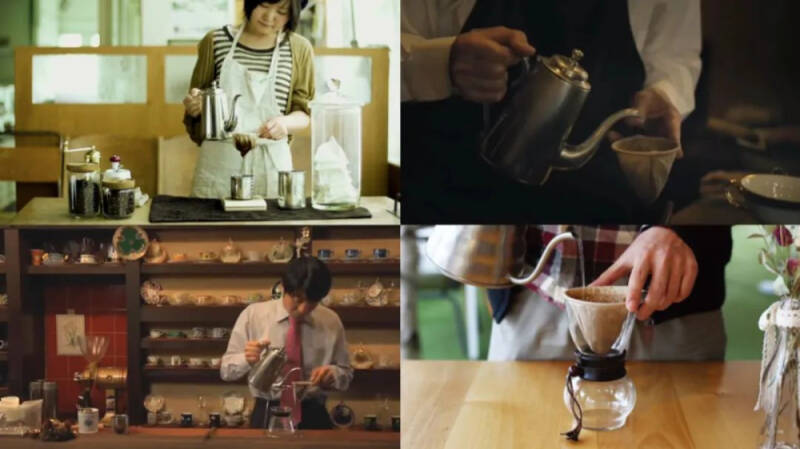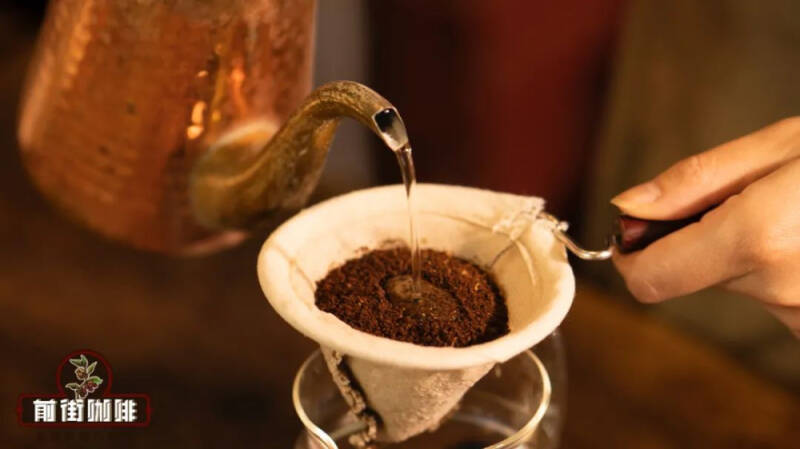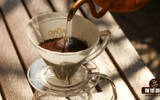Why is flannel more popular in Japan? How to flush flannelette hand?
Flannel filter cloth, it can be said that it can be used as a traditional representative of Japanese coffee! Whether in books or in any media video, we can often see the Japanese holding the filter cloth in their left hand and the coffee pot in their right hand, burying their heads to brew coffee seriously.

Seeing such attentive appearance, I can't help thinking about what kind of charm this filter cloth has to make them indulge in it. Is it possible that the coffee made by it tastes better than the coffee made with filter paper?
Flannel filter cloth flannel cloth first appeared in France, but at the beginning of flannel is not the fabric we use now, but made of wool, until the subsequent emergence of cotton material, flannel became made of coarse wool! When it comes to the role of flannel cloth, the French generally use them as a cover for containers. With the spread of flannel into Japan, the Japanese who like to delve into the method of extraction discovered its filtration characteristics, which created a cultural precedent of using flannel as a filter.

In the modern era of the popularity of filter paper, the Japanese are still addicted to using flannel filter cloth for coffee brewing, which must show that there are some characteristics that flannel can be flushed out, but filter paper is not!
The characteristics of flannel we can first think about the characteristics of filter paper: the first is that the price is suitable, the price of a pack of 100 pieces of filter paper is generally about 30-40 yuan, the average cost of a piece of filter paper is only 3-40 cents; the second feature is that the filter is extremely strong! The coffee brewed with filter paper has no residue and no miscellaneous feeling! Compared with any coffee filter, the coffee filtered out is much cleaner!
Obviously, the first feature can not be compared, after all, it is about cooking rather than price! Secondly, although flannel filter cloth is more expensive, as long as it is properly cleaned, it can be used repeatedly! Therefore, the key lies in the second feature of filter paper-filtration performance! Flannel is made of cotton, so its gap is much larger than that of filter paper, which enables grease and other insoluble substances to pass through this gap and fall into the pot, which is a feature that filter paper cannot do. So, what will happen to the coffee when these substances are filtered into the pot?
That's right! Increased the alcohol thickness of coffee! In Japan, where deep-roasted coffee is popular, the mellow taste is a very important feature of this kind of coffee, and the coffee brewed with flannel as a filtering tool has this advantage. In addition, the cooking method of flannel filter requires a certain amount of patience. In the past, due to the use of almost all deep-roasted coffee beans, which were extremely easy to extract, and most of the brewing parameters could not be measured (water temperature, liquid weight), so people need to pay close attention to all the parameters during brewing: water height, water size, coffee liquid weight, and so on. This way of brewing a pot of delicious coffee requires full input, which is very much in line with the ingenuity of the Japanese, so they "fit" with the filter cloth!
Almost all the coffee shops used flannel filter cloth, and then the people who went to the coffee shop were so impressed by the ornamental and ingenious flannel brewing that they began to use flannel as a filtering tool to extract coffee. One spread ten, ten hundred, flannel filter cloth thus spread in Japan, until after the popularity of filter cup filter paper, the use of flannel filter cloth gradually decreased.
How to cook flannel filter cloth? First of all, it is the choice of hand-held or not. if you want to experience traditional Japanese cooking, then enforcing blue velvet by hand is an essential action; but if you want to make your hands less tired, you can choose a bracket and set flannel up high, although this will reduce a lot of flexibility.
In the selection of coffee beans, because flannel is more difficult to rush out of the characteristics of shallow baked beans, so generally speaking, they are mainly deep-baked beans. In order to avoid over-extraction, the grinding is usually thicker, about 60% or 65% of the No. 20 screen. Secondly, the gap of flannel will be much thicker, and the speed of launching will be faster, so when cooking, we should not only prevent excessive bitterness caused by high temperature cooking, but also beware of insufficient extraction caused by too fast flow rate.
Therefore, flannel will use more coffee powder, and then use a small amount of hot water with finer water to prolong the extraction time, so as to increase the concentration and avoid the bitter taste of the extract (high concentration and low extraction)! Generally speaking, the amount of powder used in a person-sized filter cloth will be about 20g / 25g! While the water temperature is around 88 °C ~ hand-held flannel cooking because it is impossible to measure the powder-to-water ratio, so the powder-to-liquid ratio is usually used instead of the powder-to-water ratio calculation. The powder-to-liquid ratio of hand-enforced blue velvet will be at 1:10, and the replacement into powder-to-water ratio is 1:12. (the reason for replacement can be explained in detail in this article: the relationship between powder-to-water ratio and powder-to-liquid ratio.) when cooking, first use a small amount of hot water for steaming, and then continuously inject water into the center with a smaller flow (slowly around a small circle). Until the pot of coffee reaches the target amount of water, you can remove the filter cloth and finish brewing.
It is worth noting that we need to disinfect and clean the flannel filter cloth before and after cooking! The purpose of disinfection before cooking is to remove the negative smell attached to the filter cloth, and the disinfection after cooking is to enable the filter cloth to be reused ~ the general method of disinfection is to put it in boiling water for about five minutes, then use cold water and then wring it out.
-END-
Front Street Cafe
No. 10 Baoqian street, Yandun road, Dongshankou, Yuexiu district, Guangzhou, Guangdong province
Important Notice :
前街咖啡 FrontStreet Coffee has moved to new addredd:
FrontStreet Coffee Address: 315,Donghua East Road,GuangZhou
Tel:020 38364473
- Prev

Why is the steaming time of hand coffee 30 seconds? How to calculate the steaming time? Does stuffy steam count as a section?
Stuffy steaming, called "Bloom" in English, refers to a preparatory action before the formal extraction of coffee by hand. Many experienced coffee lovers have studied the details of water quantity, time, water injection method and so on, and summed up the foggy steaming formula with high fault tolerance and the most widely used: twice the amount of water of coffee powder (15g).
- Next

Coffee supply in Vietnam began to increase, and coffee prices began to fall.
Earlier, the Vietnamese Coffee and Cocoa Association (Vicofa) said that the price of Vietnamese coffee is expected to continue to rise in 2024 because of coffee supply shortages. The coffee production season in Vietnam is from November to March of the following year, but when the new production season began in November this year, the price of coffee had reached 60000 dong / kg.
Related
- Why does hot American coffee taste bitter? Difference in proportional concentration between hot American and ice American
- Is espresso stored overnight in the refrigerator harmful to your body? Is frozen coffee better than freshly ground coffee?
- What parameters and proportions of water temperature should be used to grind and brew fresh coffee beans? Why can't I drink freshly roasted coffee right away?
- Customers have "changed" Manner's new products! Shop assistant: Please don't mess around!
- Remove sockets in customer areas at Starbucks stores?! Netizen: I won't go if I really tear it down
- What is the difference between the taste steps of sun-dried coffee and washed coffee? Why is sun-cured coffee sweeter and washed coffee sour?
- The recipe for salty grapefruit dirty is revealed! Coffee Festival salty grapefruit dirty coffee making materials parameters ratio milk share!
- How about the flavor of Sunlight 74158 at Sidamo Banshaha Mathieu Processing Factory in Ethiopia? 74158 Share the proportion of coffee brewing parameters!
- What effect does Italian American coffee with filter paper have? Will coffee taste better if it is put on filter paper at the bottom of the powder bowl?
- What is the color difference in coffee beans? What are the characteristics of honey processed coffee beans? Why are the anaerobically treated coffee beans uneven in color?

